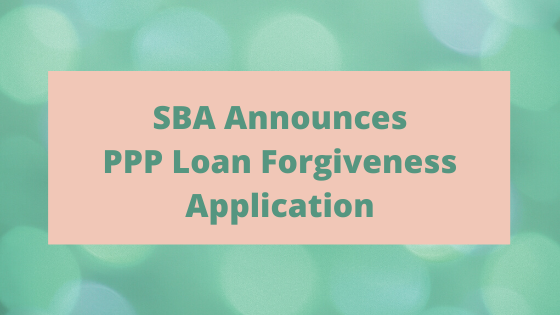Are you a sole proprietor or business owner who received a Paycheck Protection Program, otherwise known as the PPP, loan? Are you wondering the next steps in order to have your loan forgiven? The SBA has released the forgiveness application, although banks aren’t yet accepting the applications for processing.
Today’s blog will explain information to be filed on the application in order to calculate the amount of forgiveness.
PPP Overview
As a reminder, the rules regarding how the funds must be spent in order to be forgiven are very specific. They include the ratio of 75% or more to be spent on payroll related expenses and 25% or less be used toward rent, utilities, loan interest and payments on leased equipment.
The business must also maintain the same number of full-time equivalent employees as of June 30, 2020 (although a few exceptions area allowed to be described below) and employee compensation may not have been decreased more than 25%.
If the number of employees was reduced due to the following reasons, your forgiveness will not be impacted for having a lower average at the end of the loan period:
- Employees received a written offer to be rehired but they declined to return
- Employees were terminated for cause
- Employees voluntarily resigned
For those employees who earn more than $100,000 per year, the cap for compensation to be considered for forgiveness is $15,385 per worker.
Currently, the loan program states the funds must have been used within 8 weeks of the date of funding (or if funds weren’t received the day before your payroll pay date, it can be 8 weeks from the date of your first payroll after funding). However, many are petitioning that this date be extended since many businesses have not yet been able to open, and therefore unable to use all of the funds by the due date. We’ll have to see if this change is authorized.
Loan Forgiveness Application
To apply for forgiveness, the borrower must complete the application and submit to their lender. You will fill out all of the pertinent information including business name, address, contact information, PPP loan number, number of employees at the time of the application, if an EIDL advance was received, payroll schedule, and if an alternative payroll covered period is being used.
You will then need to calculate the costs for the different types of expenses to be used to determine if the funds were used appropriately in order to be forgiven. This includes mortgage interest, rent/lease payments, utilities.
If the number of employees did not remain at the same or a greater level (or wages were reduced in excess of 25%), and no exemption explained above exists, a forgiveness reduction will need to be calculated.
The borrower will need to initial next to the statements to certify the validity of the information including that the money was used according to the purposes specified and that the information provided is accurate.
The PPP Schedule A Worksheet requires all employees paid during the covered period earning less than $100,000 annually to be listed in Table 1 who reside in the U.S. and received compensation for all pay periods in 2019 or we not employed at any point in 2019. Table 2 requires anyone paid more than the annualized rate of $100,000 for any pay period.
These numbers will be used to verify the number of full-time equivalent employees did not reduce in the covered period. If a reduction occurred, a calculation will be done to determine the amount of the forgiveness reduction.
Once complete, the application will be submitted to the lending institution for verification. They will then determine the amount of forgiveness. I have not yet seen information on how this information will be relayed to the SBA and how borrowers will be given final approval that the loan has been forgiven. I assume more information will be forthcoming on the SBA process of granting forgiveness and reducing (or eliminating) the balance due.
For more information on this topic, see https://bit.ly/3bYCjBa
